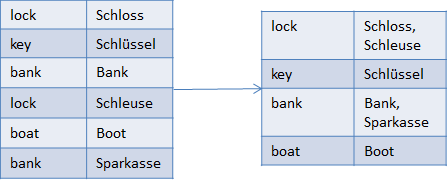Using Merge on a Single File
Normally, merging involves two or more files. But you can actually use merging functionality to clean up existing term lists. Always keep in mind, though, that merging is a tricky business and might have unexpected side effects.
Merging Duplicates
A typical use case would be a simple two-column spreadsheet that you created by copy and paste from various sources and versions. You have no idea if there were duplicates in them, and don't care about homonyms, you just want a bilingual termbase. In that case, you can convert the "dirty" termbase and the result will have one entry per source term, collecting different translations. Look at the example: it merges both bank (synonyms) and lock (homonyms). Not perfect, but that's human language for you.

Merging Languages
Another possible use case is to combine two languages into one. If you don't care about language variants, but have a termbase that contains them in separate columns, you can convert the termbase with the merge language setting activated.

Created with the Personal Edition of HelpNDoc: Easily create EBooks